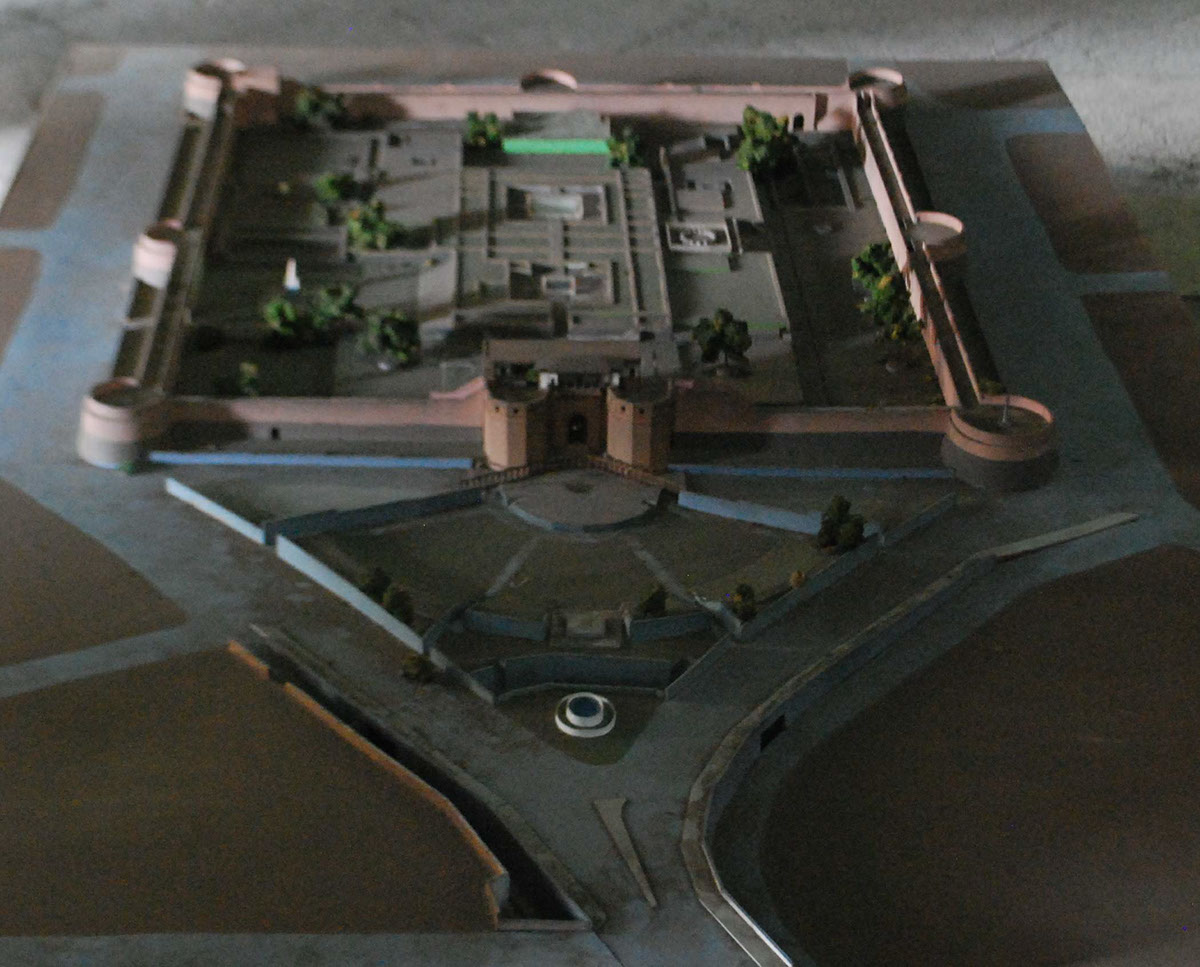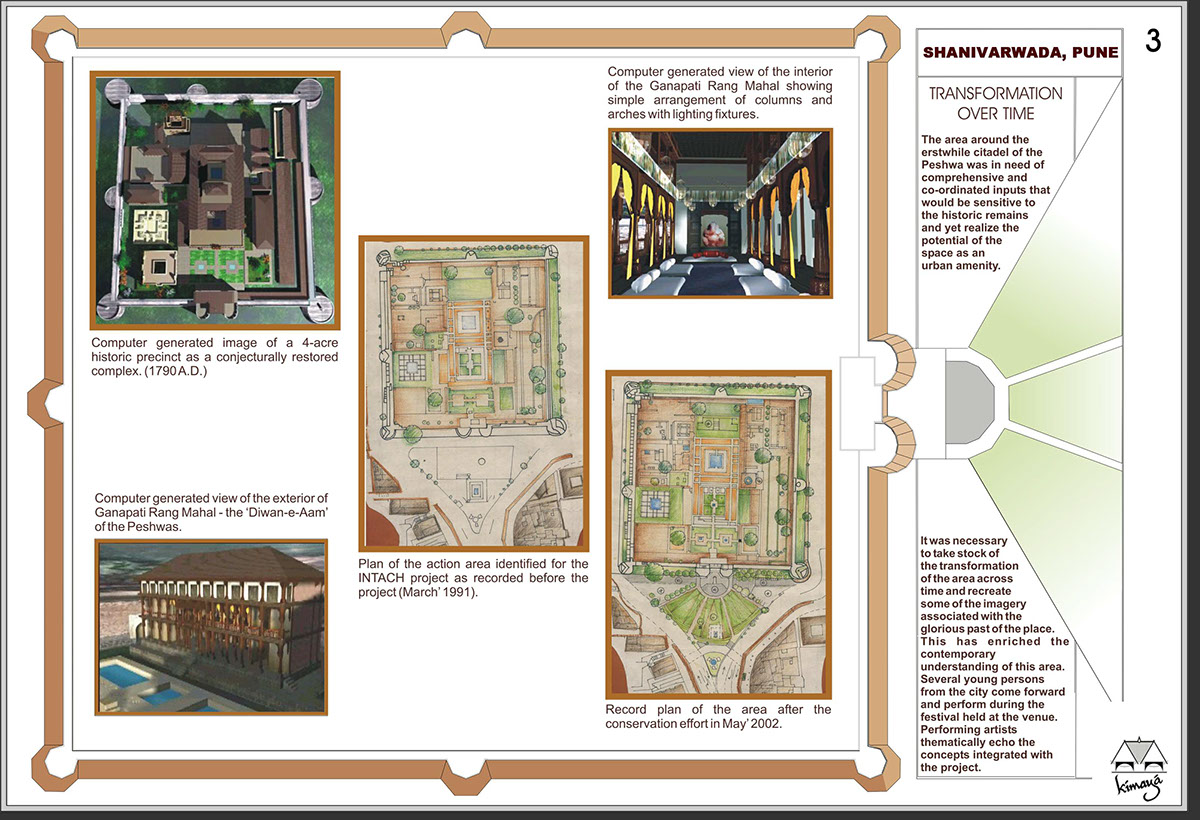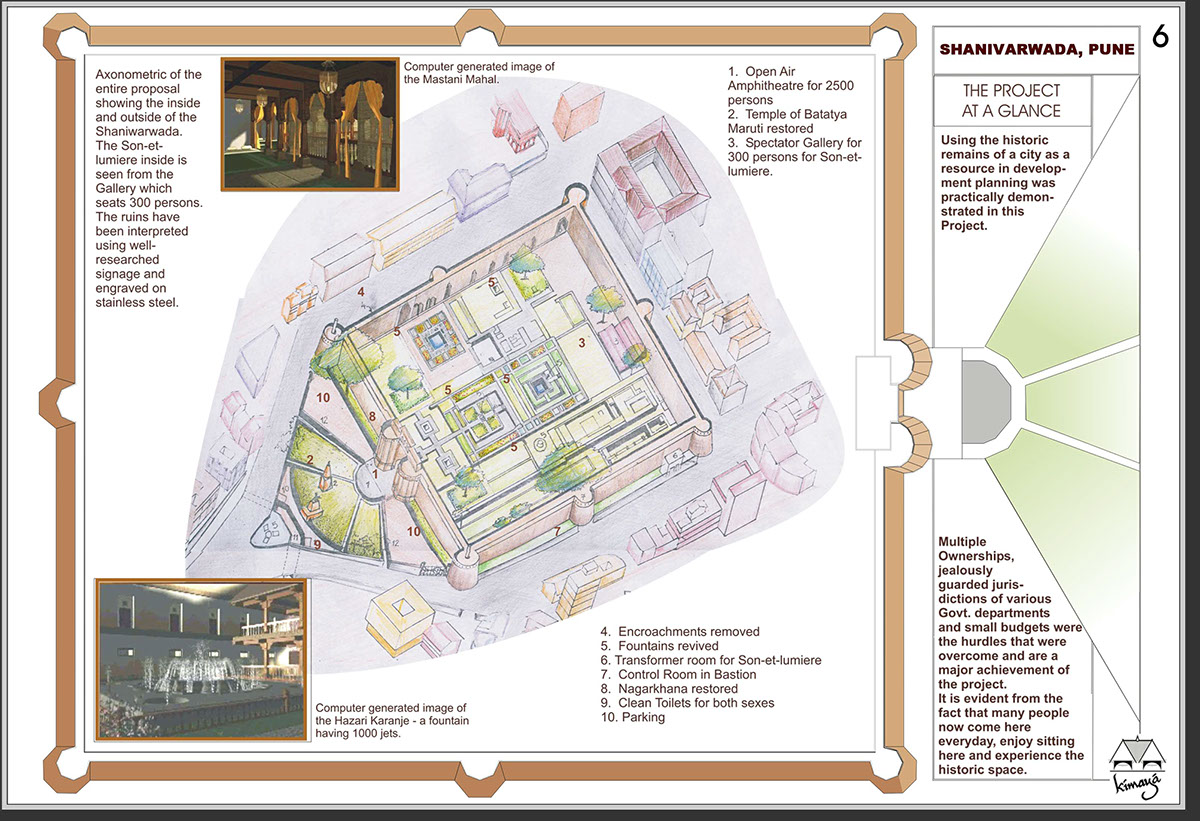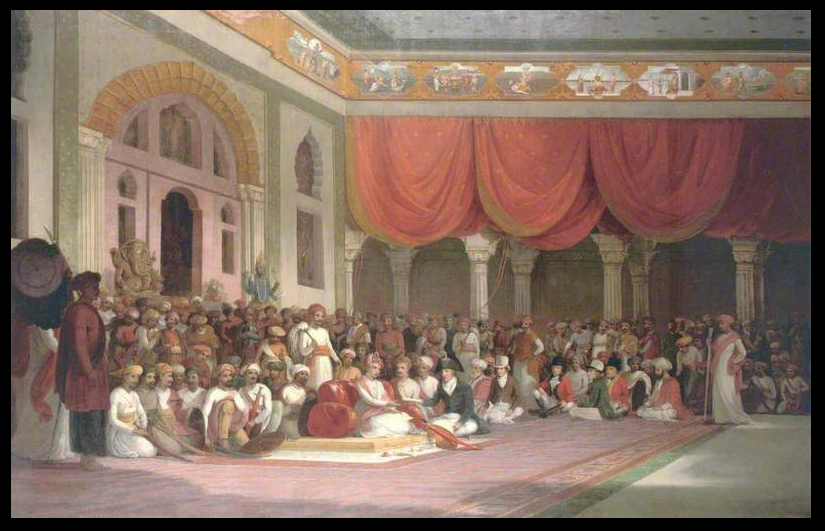
This year in June 2016 the spectator's gallery got a new structure as the old structure had corroded beyond repair and a set of new powder coated stainless steel chairs was also added. Four speakers at the back were also added. Ventilation for the space below the chairs was a prime reason for the corrosion of the structure below which was in steel.

This historic precinct was a place from where the Marathas virtually ruled over 18th century India before the colonizers took over India. We were responsible for the redesign and revitalization of this national monument that had fallen into disuse, neglect and obsolescence.

A festival of local fabrics was held at the venue where members participated wearing the traditional fabric of the city. Seen in the picture from left to right are Monika Trivedi (below Warsaa board) Vinita Deshmukh (in blue saree standing in the distance) and Arnavaz Damania (extreme right middle in black T shirt).

Inside the monument which was burnt down during the British Rule, a structure was added to house a conjectural model of the erstwhile citadel in its full glory. The character and material of the new addition had to be in keeping with the historic fabric.

The new openair theatre conceived and build as a cultural platform for the vibrant traditions of performing arrts of the city is actively used and appreciated by the visitors and inmates of the city alike.








Transformation of a Public Open Spacewithin a Historic Context
ANJALI& KIRAN KALAMDANI,
‘KIMAYA’URBAN DESIGNERS & CONSERVATION ARCHITECTS
REVITALIZING ENVIRONS OF SHANIWARWADA,PUNE
Synopsis of conservation projectShaniwarwadathe eighteenth century citadel of the Peshwas in Pune was the virtual capitalof Indiafor a century between AD1732 and 1818. It was burnt down by the British inAD1827. In the colonial period the 5.75 acre campus was presented as anarchaeological ruin with plinths inside surrounded by a nine-bastionedfortified wall and five gates. During the freedom struggle the place was apolitical dais from where activists voiced their opinions and used the historyto incite National Pride. The area outside was reduced to a passive recreationalground and a neglected ruin with little or no interpretation, for fifty yearsin post-independence India.In 1991 the Indian National Trust for Art and Cultural Heritage (INTACH)appointed the architects to prepare a Perspective Plan for the project. ‘RevitalizingEnvirons of Shaniwarwada, Pune’. All the stakeholders of the area were enlistedand their needs, problems, potential and suggestions were addressed in theVision Statement.
When implementation began in1999 the architects were invited to join the team with noted historians,corporates, central, state and local government officials to implement thePerspective Plan. The open-air theatre, the son-et-lumiere, virtual conjecturalrestoration aiding in interpretation of the ruins, a souvenir shop and a ‘social’wall was built around the ruins. Several encroachments, inconsistencies andeye-sores were removed to make the area a better place for the tourist and thecitizen. Several festivals cultural performances and experimental mixed-mediaperformances are now held in the area to proclaim it as the revitalizedcenter-stage of Contemporary Pune.
Conservationproject’s goals and objectives (client’s brief)
PROLOGUE
Urbanspace in pre-industrial Indian cities is characterised by traumatictransitions. Living patterns are tornbetween changing social orders reflecting in transitional life support systemsand the omnipresent cultural continuum.
A rich mix of myth, religion, historyand heritage seem to be fighting a loosing battle with overcrowding, poverty,pollution, traffic jams and thoughtless renewal.
It might be a long time before theIndian urbanite comes to terms with the machine. Meanwhile the election-crazy politician andhis puppet bureaucrat are busy building monuments to themselves in urbanspace. Their stepbrother, the corporateexecutive is happy with cosmetic surgery or monumental disasters. The well-meaning bureaucrat and thewell-intentioned politician are too often silenced. It is high time the man at the receiving endwakes up to his impending doom and forges the path to his own salvation.
Revitalizing Shaniwar Wada and itsenvirons is but one step in this long and treacherous journey
Kiran Kalamdani, Feb.’ 91
Though the initial small steps were taken withpessimism on account of the non starters seen in similar projects across thecountry, the patience and diligence of the long term has paid off. The Architects were responsible for the project report commissioned byINTACH (New Delhi)entitled ‘Revitalizing Environs of Shaniwar Wada’. Salient Features of theproject report were:
a) Re-establishing the Shaniwar Wadaas a focus of cultural activities in Pune by constructing an Open Air Theatrein the open ground opposite the wada – creative, urbane and healthy activitieswere to be promoted by this reprofiling.
b) Removal of encroachments around themonument to restore its authenticity and enhance its historic value
c) Providing a boost to tourism in andaround the wada by introducing infrastructure that will bring history alive inthe form of Son-et-lumiere, interpretative signage, conjectural models,souvenirs and guided walks.
d) Promoting participation of all thestakeholders viz. Citizens of Pune, philanthropists and entrepreneurs,bureaucrats, politicians, historians, central, state and local governments,experts and talented persons to transform the area into a cultural venue of notonly Pune but modern India.
The background of the propertyHistorical Background:
Shaniwarwadawas the most stately and prestigious fortified palace built by the Peshwas(Prime Ministers) of the Maratha Kings in AD1732 in Pune. The Peshwas were aBrahminical race who expanded Chhatrapati Shivaji’s kingdom into and empirethat stretched over a territory that was from Attock in Afghanistan inthe west to Bengal in the east and Tanjore inthe South to Kashmir in the north. It was theunproclaimed capital of the Maratha confederacy for a period of about a century(between 1710 and 1818 AD) after which it was taken over by the British inAD1818. It was not only seen as the political center, but came to be known asthe virtual Cultural Capital of the Marathi-speaking people. Architecturallythe Dilli Darwaza (Main Gate facing Delhi)is an icon that symbolizes Pune City. It is therefore themost popular and representative icon of heritage values of Pune. The projectarticulates this significance at all levels so that the importance ofShaniwarwada in cultural memory is enhanced. The palace was burnt down in afire in 1827 and lay as a ruin for another seventy years. It was then broughtunder the fold of the Archaeological Survey of India in 1911. Excavation andpresentation of ruins were carried out for thirty years. In 1952 there was a ‘PM Lad Committee’ that was set up to undertake the reconstruction of some partof the buildings inside and set up a library. Though this never happened, asystematic study of the ruins, records and establishment of the former use ofspaces was completed. The INTACH initiative of 1991 followed by theimplementation in 1991 to 2001 has rendered the site as an active heritage sitethat has intertwined successfully with the contemporary culture of Pune.
Present context, condition, use of the property:In the present context the site offers a variety ofexperiences for different classes of people. For the heritage enthusiast thereis a cleaner and better-maintained ruin with interpretation and facilities fordrinking water, toilets and souvenirs. The urbanites living in the vicinityhave a green space to use in the mornings and evenings where children can playin a vehicle free zone. Occasionally festivals and cultural performances areheld that can be enjoyed at a low or no cost. The level of maintenance insideand outside the premises is of a higher order though there is scope for furtherimprovement.
ANJALI& KIRAN KALAMDANI,
‘KIMAYA’URBAN DESIGNERS & CONSERVATION ARCHITECTS
REVITALIZING ENVIRONS OF SHANIWARWADA,PUNE
Synopsis of conservation projectShaniwarwadathe eighteenth century citadel of the Peshwas in Pune was the virtual capitalof Indiafor a century between AD1732 and 1818. It was burnt down by the British inAD1827. In the colonial period the 5.75 acre campus was presented as anarchaeological ruin with plinths inside surrounded by a nine-bastionedfortified wall and five gates. During the freedom struggle the place was apolitical dais from where activists voiced their opinions and used the historyto incite National Pride. The area outside was reduced to a passive recreationalground and a neglected ruin with little or no interpretation, for fifty yearsin post-independence India.In 1991 the Indian National Trust for Art and Cultural Heritage (INTACH)appointed the architects to prepare a Perspective Plan for the project. ‘RevitalizingEnvirons of Shaniwarwada, Pune’. All the stakeholders of the area were enlistedand their needs, problems, potential and suggestions were addressed in theVision Statement.
When implementation began in1999 the architects were invited to join the team with noted historians,corporates, central, state and local government officials to implement thePerspective Plan. The open-air theatre, the son-et-lumiere, virtual conjecturalrestoration aiding in interpretation of the ruins, a souvenir shop and a ‘social’wall was built around the ruins. Several encroachments, inconsistencies andeye-sores were removed to make the area a better place for the tourist and thecitizen. Several festivals cultural performances and experimental mixed-mediaperformances are now held in the area to proclaim it as the revitalizedcenter-stage of Contemporary Pune.
Conservationproject’s goals and objectives (client’s brief)
PROLOGUE
Urbanspace in pre-industrial Indian cities is characterised by traumatictransitions. Living patterns are tornbetween changing social orders reflecting in transitional life support systemsand the omnipresent cultural continuum.
A rich mix of myth, religion, historyand heritage seem to be fighting a loosing battle with overcrowding, poverty,pollution, traffic jams and thoughtless renewal.
It might be a long time before theIndian urbanite comes to terms with the machine. Meanwhile the election-crazy politician andhis puppet bureaucrat are busy building monuments to themselves in urbanspace. Their stepbrother, the corporateexecutive is happy with cosmetic surgery or monumental disasters. The well-meaning bureaucrat and thewell-intentioned politician are too often silenced. It is high time the man at the receiving endwakes up to his impending doom and forges the path to his own salvation.
Revitalizing Shaniwar Wada and itsenvirons is but one step in this long and treacherous journey
Kiran Kalamdani, Feb.’ 91
Though the initial small steps were taken withpessimism on account of the non starters seen in similar projects across thecountry, the patience and diligence of the long term has paid off. The Architects were responsible for the project report commissioned byINTACH (New Delhi)entitled ‘Revitalizing Environs of Shaniwar Wada’. Salient Features of theproject report were:
a) Re-establishing the Shaniwar Wadaas a focus of cultural activities in Pune by constructing an Open Air Theatrein the open ground opposite the wada – creative, urbane and healthy activitieswere to be promoted by this reprofiling.
b) Removal of encroachments around themonument to restore its authenticity and enhance its historic value
c) Providing a boost to tourism in andaround the wada by introducing infrastructure that will bring history alive inthe form of Son-et-lumiere, interpretative signage, conjectural models,souvenirs and guided walks.
d) Promoting participation of all thestakeholders viz. Citizens of Pune, philanthropists and entrepreneurs,bureaucrats, politicians, historians, central, state and local governments,experts and talented persons to transform the area into a cultural venue of notonly Pune but modern India.
The background of the propertyHistorical Background:
Shaniwarwadawas the most stately and prestigious fortified palace built by the Peshwas(Prime Ministers) of the Maratha Kings in AD1732 in Pune. The Peshwas were aBrahminical race who expanded Chhatrapati Shivaji’s kingdom into and empirethat stretched over a territory that was from Attock in Afghanistan inthe west to Bengal in the east and Tanjore inthe South to Kashmir in the north. It was theunproclaimed capital of the Maratha confederacy for a period of about a century(between 1710 and 1818 AD) after which it was taken over by the British inAD1818. It was not only seen as the political center, but came to be known asthe virtual Cultural Capital of the Marathi-speaking people. Architecturallythe Dilli Darwaza (Main Gate facing Delhi)is an icon that symbolizes Pune City. It is therefore themost popular and representative icon of heritage values of Pune. The projectarticulates this significance at all levels so that the importance ofShaniwarwada in cultural memory is enhanced. The palace was burnt down in afire in 1827 and lay as a ruin for another seventy years. It was then broughtunder the fold of the Archaeological Survey of India in 1911. Excavation andpresentation of ruins were carried out for thirty years. In 1952 there was a ‘PM Lad Committee’ that was set up to undertake the reconstruction of some partof the buildings inside and set up a library. Though this never happened, asystematic study of the ruins, records and establishment of the former use ofspaces was completed. The INTACH initiative of 1991 followed by theimplementation in 1991 to 2001 has rendered the site as an active heritage sitethat has intertwined successfully with the contemporary culture of Pune.
Present context, condition, use of the property:In the present context the site offers a variety ofexperiences for different classes of people. For the heritage enthusiast thereis a cleaner and better-maintained ruin with interpretation and facilities fordrinking water, toilets and souvenirs. The urbanites living in the vicinityhave a green space to use in the mornings and evenings where children can playin a vehicle free zone. Occasionally festivals and cultural performances areheld that can be enjoyed at a low or no cost. The level of maintenance insideand outside the premises is of a higher order though there is scope for furtherimprovement.

old photograph of the foreground of the wada probably from the 1920s where a memorial for soldiers martyred in the First World War was erected (pinted finger) and is now shifted to a location 5km south of this monument.
Scanned image of a photograph of a portrait of Sadashivrao Bhau a warrior who was killed in the battle of Panipat in 1761. He was a great warrior and a handsome young man.
Bajirao Peshwe I who was responsible for expanding the Maratha Confederacy upto Attock in Afghanisthan, Bengal to the east and Tanjore to the south lived for 40 years, fought 40 battles and won each one of them! The portrait is a Marathi styled miniature that was influenced by the Jaipur school of miniatures.

Some of the paintings of the Maratha Greats were temporarily displayed in the Nagarkhana of Shaniwarwada and are awaiting a proper display in the following years. The Gallery is funded by the late Mr B G Deshmukh who was the chairman of the Executive and Advisory Committee set up for the work.
The openair theatre doubles up as an urban space where people from the old city gather to use for quiet convesations and watching people in the evenings.

The erstwhile residence of the Peshwas (Prime Ministers of the Mrathas at Satara) was burnt down during the British Rule and reduced to mere plinths - an archaeological ruin which was once a seven storeyed bustling place where about a 1000 people lived or worked.

This is a conjectural restoration of what the entire might have looked like before it was burnt in 1829.

B/W copy of the Poona Durbar a painting by Thomas and William Daniels from sketches by James Wales an artist who is seated among the Englishmen. This is the only but somewhat exhaaggerated version of the interiors of the Ganpati Ranga Mahal a sort of Diwan-i-aam of the Peshwas. Shrimant Sawai Madhavrao Peshwa is being assisted by Nana Phadanvis in signing a treaty against Tipu Sultan in association with the Nizam of Hyderabad a typical move of the resident Charles Malet who commissioned this painting as a feather in his cap.

Copy of the original in colour.
close view of the central characters
Eveningers gather at this historic space to savour the cool summer winds and watch other people to feel social.


